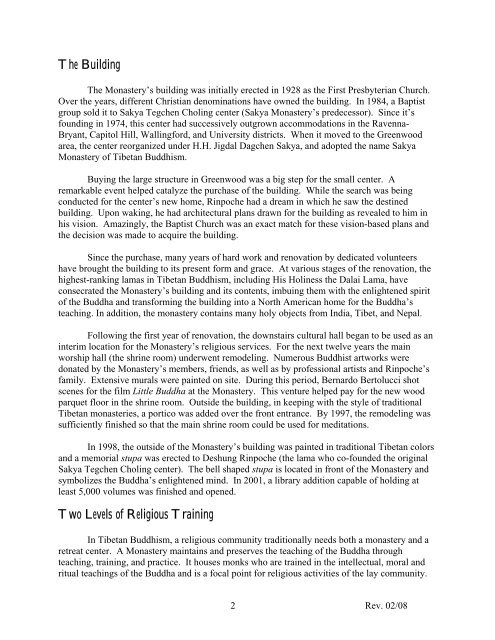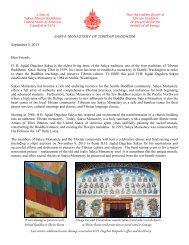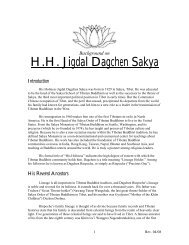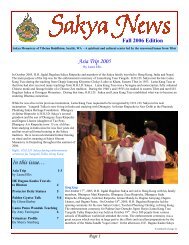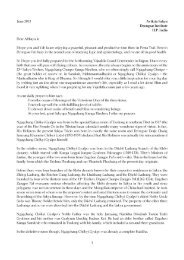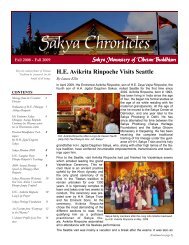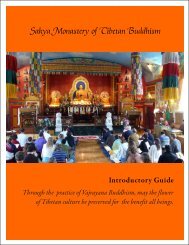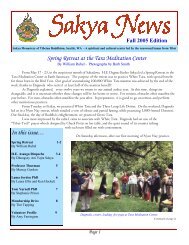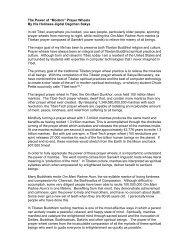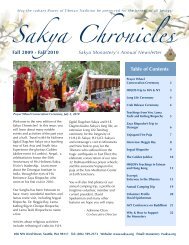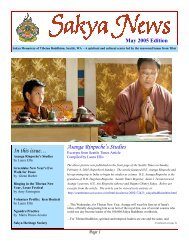Sakya Monastery.pdf - the Sakya Monastery of Tibetan Buddhism
Sakya Monastery.pdf - the Sakya Monastery of Tibetan Buddhism
Sakya Monastery.pdf - the Sakya Monastery of Tibetan Buddhism
Create successful ePaper yourself
Turn your PDF publications into a flip-book with our unique Google optimized e-Paper software.
The BuildingThe <strong>Monastery</strong>’s building was initially erected in 1928 as <strong>the</strong> First Presbyterian Church.Over <strong>the</strong> years, different Christian denominations have owned <strong>the</strong> building. In 1984, a Baptistgroup sold it to <strong>Sakya</strong> Tegchen Choling center (<strong>Sakya</strong> <strong>Monastery</strong>’s predecessor). Since it’sfounding in 1974, this center had successively outgrown accommodations in <strong>the</strong> Ravenna-Bryant, Capitol Hill, Wallingford, and University districts. When it moved to <strong>the</strong> Greenwoodarea, <strong>the</strong> center reorganized under H.H. Jigdal Dagchen <strong>Sakya</strong>, and adopted <strong>the</strong> name <strong>Sakya</strong><strong>Monastery</strong> <strong>of</strong> <strong>Tibetan</strong> <strong>Buddhism</strong>.Buying <strong>the</strong> large structure in Greenwood was a big step for <strong>the</strong> small center. Aremarkable event helped catalyze <strong>the</strong> purchase <strong>of</strong> <strong>the</strong> building. While <strong>the</strong> search was beingconducted for <strong>the</strong> center’s new home, Rinpoche had a dream in which he saw <strong>the</strong> destinedbuilding. Upon waking, he had architectural plans drawn for <strong>the</strong> building as revealed to him inhis vision. Amazingly, <strong>the</strong> Baptist Church was an exact match for <strong>the</strong>se vision-based plans and<strong>the</strong> decision was made to acquire <strong>the</strong> building.Since <strong>the</strong> purchase, many years <strong>of</strong> hard work and renovation by dedicated volunteershave brought <strong>the</strong> building to its present form and grace. At various stages <strong>of</strong> <strong>the</strong> renovation, <strong>the</strong>highest-ranking lamas in <strong>Tibetan</strong> <strong>Buddhism</strong>, including His Holiness <strong>the</strong> Dalai Lama, haveconsecrated <strong>the</strong> <strong>Monastery</strong>’s building and its contents, imbuing <strong>the</strong>m with <strong>the</strong> enlightened spirit<strong>of</strong> <strong>the</strong> Buddha and transforming <strong>the</strong> building into a North American home for <strong>the</strong> Buddha’steaching. In addition, <strong>the</strong> monastery contains many holy objects from India, Tibet, and Nepal.Following <strong>the</strong> first year <strong>of</strong> renovation, <strong>the</strong> downstairs cultural hall began to be used as aninterim location for <strong>the</strong> <strong>Monastery</strong>’s religious services. For <strong>the</strong> next twelve years <strong>the</strong> mainworship hall (<strong>the</strong> shrine room) underwent remodeling. Numerous Buddhist artworks weredonated by <strong>the</strong> <strong>Monastery</strong>’s members, friends, as well as by pr<strong>of</strong>essional artists and Rinpoche’sfamily. Extensive murals were painted on site. During this period, Bernardo Bertolucci shotscenes for <strong>the</strong> film Little Buddha at <strong>the</strong> <strong>Monastery</strong>. This venture helped pay for <strong>the</strong> new woodparquet floor in <strong>the</strong> shrine room. Outside <strong>the</strong> building, in keeping with <strong>the</strong> style <strong>of</strong> traditional<strong>Tibetan</strong> monasteries, a portico was added over <strong>the</strong> front entrance. By 1997, <strong>the</strong> remodeling wassufficiently finished so that <strong>the</strong> main shrine room could be used for meditations.In 1998, <strong>the</strong> outside <strong>of</strong> <strong>the</strong> <strong>Monastery</strong>’s building was painted in traditional <strong>Tibetan</strong> colorsand a memorial stupa was erected to Deshung Rinpoche (<strong>the</strong> lama who co-founded <strong>the</strong> original<strong>Sakya</strong> Tegchen Choling center). The bell shaped stupa is located in front <strong>of</strong> <strong>the</strong> <strong>Monastery</strong> andsymbolizes <strong>the</strong> Buddha’s enlightened mind. In 2001, a library addition capable <strong>of</strong> holding atleast 5,000 volumes was finished and opened.Two Levels <strong>of</strong> Religious TrainingIn <strong>Tibetan</strong> <strong>Buddhism</strong>, a religious community traditionally needs both a monastery and aretreat center. A <strong>Monastery</strong> maintains and preserves <strong>the</strong> teaching <strong>of</strong> <strong>the</strong> Buddha throughteaching, training, and practice. It houses monks who are trained in <strong>the</strong> intellectual, moral andritual teachings <strong>of</strong> <strong>the</strong> Buddha and is a focal point for religious activities <strong>of</strong> <strong>the</strong> lay community.2 Rev. 02/08


